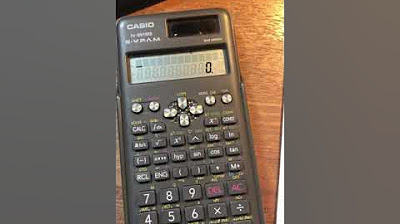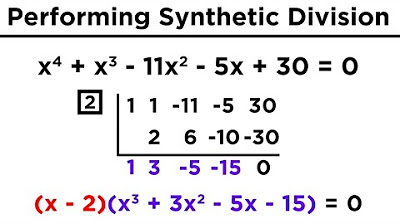Quadratic and Cubic Equations | Calculator Techniques | Engineering Board Exam | #AbatAndChill
TLDRIn this educational video, the host discusses calculator techniques for solving quadratic and cubic equations, essential for engineering board exams. The script guides viewers through using the calculator's equation mode to find roots, emphasizing the importance of entering coefficients correctly. It also covers how to handle repeated roots, factor equations, and reciprocal roots, as well as solving higher degree polynomials and verifying solutions. The video aims to help students apply these techniques effectively for their exams, encouraging practice and understanding of the concepts.
Takeaways
- 🧮 Today's topic is calculator techniques for solving quadratic and cubic equations in the engineering board exam.
- 📐 Example 1: Solve for the roots of the quadratic equation y = 2x² + x - 6 using the calculator's equation mode.
- 📝 Step-by-step: Set the mode to equation (mode 5), choose quadratic (option 3), and input the coefficients. The roots are found to be 3/2 and -2.
- 🔄 Example 2: For the equation y = 9x² - 12x + 4, the roots are found to be 2/3 with a repeated root, using the same method.
- ➗ Example 3: Given the factors of a quadratic equation, find the original equation by solving the factors and substituting back to check the roots.
- 🔍 Example 4: Find the equation whose roots are the reciprocals of the given equation 2x² - 3x - 5 = 0. Use the calculator to find the roots and then the reciprocal values.
- 🧩 Example 5: Determine the factors of a fourth-degree polynomial by splitting and solving using quadratic techniques on the calculator.
- 🔢 Example 6: Given the roots -1, 2, and 4, find the equation by substituting these roots into the options to find which equation returns zero.
- 🔄 Example 7: Solve the equation with given roots by reverse engineering using the calculator to check each option for consistency.
- 🧠 Final note: Understanding and applying these calculator techniques can significantly simplify solving polynomial equations during exams. Remember to practice and share these techniques with peers.
Q & A
What is the main topic discussed in the video?
-The main topic discussed in the video is calculator techniques for solving quadratic and cubic equations, specifically for engineering board exams.
What mode should be selected on the calculator to solve quadratic equations?
-To solve quadratic equations, the mode 'equation mode 5' should be selected on the calculator, and then option '3' for ax squared plus bx plus c.
How many roots does a quadratic equation typically have?
-A quadratic equation typically has two roots.
What is the process to find the roots of the equation y = 2x^2 + x - 6 using a calculator?
-To find the roots of y = 2x^2 + x - 6, set y to zero and input the coefficients into the calculator in the form abc, where a=2, b=1, and c=-6. The calculator will then provide the two roots.
What does it mean if a calculator provides only one value for a quadratic equation?
-If a calculator provides only one value for a quadratic equation, it indicates that there is a repeating root, meaning both roots are the same.
How can you verify if a certain value is a root of a quadratic equation?
-To verify if a certain value is a root of a quadratic equation, you can substitute that value into the equation and check if the result is zero.
What is the purpose of finding the factors of a quadratic equation in the video?
-The purpose of finding the factors of a quadratic equation is to determine the original equation when given the roots, which can be used to answer related questions.
How can you find the equation with roots that are reciprocals of the roots of another given equation?
-First, find the roots of the given equation using a calculator. Then, take the reciprocals of those roots and substitute them into the multiple-choice options to find which equation yields zero for both reciprocals.
What is the strategy for solving the problem involving the equation with x raised to the fourth power?
-Since calculators can only solve up to the third power, the strategy is to split the x raised to the fourth power into x squared and another x squared, excluding the y terms, and then solve for the roots in the x terms.
How can you determine the equation given its roots?
-Substitute the given roots into the multiple-choice options and check which equation results in zero when all the roots are substituted, indicating that those are the actual roots of the equation.
What is the method used in the video to find the solution of an equation with multiple choices?
-The method involves reverse engineering by typing the equation into the calculator and comparing the values obtained from the choices to find the correct solution.
Outlines
📚 Introduction to Calculator Techniques for Engineering Exams
The video script begins with an introduction to calculator techniques specifically tailored for engineering board exams. The focus is on solving quadratic and cubic equations using a calculator, emphasizing the roots of these polynomial equations. The first example demonstrates how to use the calculator's equation mode to find the roots of a quadratic equation, 'y = 2x^2 + x - 6', by entering the coefficients and utilizing the quadratic equation solving function. The explanation includes a brief mention of manual computation methods but highlights the ease of using a calculator for such tasks.
🔍 Detailed Explanation of Quadratic Equation Roots
This paragraph delves deeper into solving quadratic equations, using the example 'y = 9x^2 - 12x + 4'. It explains the process of entering the coefficients into the calculator and interpreting the result, which in this case yields a single repeating root, '2/3'. The script clarifies that despite the calculator showing one value, it represents two identical roots for the quadratic equation. The importance of checking the root's validity by substituting it back into the original equation is also discussed.
📝 Deriving a Quadratic Equation from Given Factors
The script moves on to constructing a quadratic equation from its given factors, '3x - 1' and '4x - 1'. It outlines the steps to find the roots of these factors, which are '1/3' and '1/4', and then demonstrates how to verify these roots by substituting them into the candidate equations provided in multiple-choice format. The correct quadratic equation is identified by ensuring that both roots yield a remainder of zero when substituted.
🔄 Finding Equations with Reciprocal Roots
The fourth paragraph discusses a unique problem where the roots of a given quadratic equation, '2x^2 - 3x - 5 = 0', are used to find an equation whose roots are the reciprocals of the original. The process involves finding the roots of the given equation using the calculator, taking their reciprocals, and then testing multiple-choice options to find which equation these reciprocal roots satisfy.
📉 Solving Higher Degree Equations with Calculator Limitations
This section tackles a higher degree equation, '2x^4 + 11x^2y^2 - 6y^4', and explains the strategy for solving it with a calculator that can only handle up to cubic equations. The approach involves breaking down the equation and solving for 'x^2' while ignoring 'y^2'. The script explains how to interpret the calculator's output and match it with the correct factor from the multiple-choice options.
🔑 Constructing an Equation from Given Roots
The script presents a method for constructing an equation when its roots are already known, such as '-1', '2', and '4'. It describes a trial-and-error process of substituting these roots into multiple-choice equations to find which one yields zero for all roots, thereby confirming it as the correct equation.
🎯 Solving Equations Using Reverse Engineering
The final paragraph of the script discusses solving an equation 'x^2 - 2x' by using reverse engineering with a calculator. It explains how to input the equation and the potential roots from the choices to find which one satisfies the equation. The process involves comparing the values obtained from the left and right sides of the equation to determine the correct solution.
🙌 Conclusion and Call to Action
The video concludes with a summary of the importance of mastering calculator techniques for engineering exams and encourages viewers to apply these skills. The presenter invites viewers to subscribe to the channel and share the video with peers. The closing remarks are from the engineer, India Abbat, who wishes the viewers success in their exams and ends with a note of gratitude and well-wishes.
Mindmap
Keywords
💡Calculator Techniques
💡Quadratic Equation
💡Cubic Equation
💡Roots
💡Polynomials
💡Mode Equation
💡Coefficients
💡Standard Form
💡Repetition of Roots
💡Factoring
💡Reciprocals
💡Remainder Theorem
Highlights
Introduction to calculator techniques for solving engineering board exam problems, focusing on quadratic and cubic equations.
Explanation of using the calculator's equation mode to solve for roots of quadratic equations.
Demonstration of inputting coefficients into the calculator for solving quadratic equations.
Discussion on the number of roots expected from quadratic and cubic equations.
Manual computation methods versus calculator techniques for finding roots.
Using the calculator to find roots of the equation y = 9x^2 - 12x + 4, resulting in a repeating root.
Verification of the root found using the calculator by substituting it back into the polynomial.
Finding the quadratic equation given its factors 3x - 1 and 4x - 1.
Process of isolating x to find the roots from the factors of a quadratic equation.
Using calculator techniques to identify the correct quadratic equation from multiple choices.
Finding an equation with roots that are reciprocals of the given roots of 2x^2 - 3x - 5 = 0.
Method of reciprocating roots and substituting them into multiple choices to find the correct equation.
Solving for factors of an equation involving x^4 and y^4 by breaking it down into solvable parts.
Identifying the correct factor from choices by substituting calculated roots.
Constructing the equation from given roots using trial and error with calculator.
Reverse engineering to find solutions of an equation by comparing values from choices.
Final problem solution using calculator to verify the correct answer among multiple choices.
Encouragement to apply these calculator techniques for the engineering board exam and subscription call to action.
Transcripts
Browse More Related Video

Factorizing Using Casio 570MS Calculator

How to solve a quadratic equation with Casio fx-991MS edition 2 scientific calculator

Calculator Techniques for ENGINEERING BOARD EXAM: Solving for X, USING SHIFT SOLVE | 10 PROBLEMS

Solving Higher-Degree Polynomials by Synthetic Division and the Rational Roots Test

CALCULATOR TECHNIQUES: BOARD EXAM REVIEW PART 1

How To Find The Real & Imaginary Solutions of Polynomial Equations
5.0 / 5 (0 votes)
Thanks for rating: